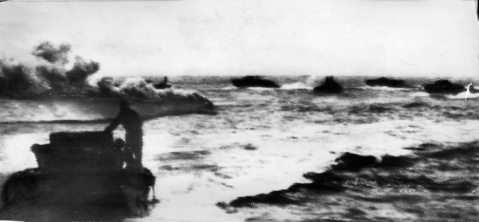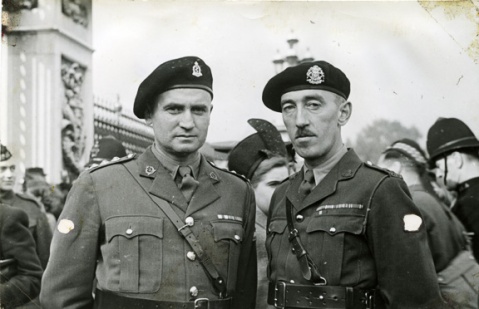Doc Alexander featured in Calgary Sun’s Remembrance Day coverage
My thanks to Bill Kaufmann of the Calgary Sun for taking an interest in my grandfather’s story. He wrote a story – Wartime diaries bring Canmore journalist closer to grandfather he never knew – that ran Sunday in the Sun over a two-page spread sharing my grandfather’s story with Calgary and area readers. One of my goals with this project is simply to share what until now was a family story, and stories such as what Bill wrote truly help. For that I’m very appreciative.
Nov. 11, 1942
Armistice Day again – the second year away from home. Let us hope it will be the last. This afternoon Bert Rutledge and I went down in our Jeep to the 8th Field Ambulance. we came home with a gallon of Dettol, a pound of Sulphanilamide, eight hot water bottles and a hundred and fifty syrettes – part of the spoilt of a box which I brought home from Dieppe, and the 8th picked up at Newhaven. I am going down on the 16th to speak to the Unit on Dieppe. No mail yet.
Oil, Water and Blood: A Remembrance Day lecture
In honour of the 70th anniversary of the Dieppe Raid and Remembrance Day, join me as I share my grandfather’s story at Dieppe with Oil, Water and Blood: the Dieppe journal of Doc Alexander a lecture at the Canmore Museum & Geoscience Centre Thursday, Nov. 8 at 7 p.m.
At the start of the Dieppe Raid of August 19, 1942, Dr. Laurence Guy Alexander, a Calgary doctor and medical officer for the 14th Canadian Army Tank Battalion – the Calgary Regiment (Calgary Tanks) – waited aboard a tank landing craft for his turn to storm the rocky beach at Dieppe, France.
Oil, Water and Blood: the Dieppe Raid journal of Doc Alexander explores Alexander’s harrowing experience during the raid. It was, he wrote,worse than what he had experienced as a young man serving in the First World War.
“Anything I saw in the whole of the last war – and I saw plenty there – nothing can in the slightest compare with this. A combination of fire from every direction, both sides, in front, behind, above and below, and every conceivable type of weapons pretty well sizes up the situation,” he wrote.
Tickets are $10 and are available at the Canmore Museum.
Oct. 27, 1942 – Investiture
For their actions at Dieppe during the raid, Doc Alexander received the Military Cross for devotion to duty during the Dieppe Raid and Lt.-Col. John Begg, the Distinguished Service Order.
The next morning after breakfast, we walk across Green Park to Buckingham Palace, where we line up in queue outside the railing. At 10 a.m. we file through the archway to the Inner Court, and then into the Lobby of the Palace where we are divided into rooms, according to our decoration. We are given instructions, the hooks are hung onto our tunics, and we get lined up in proper order.
At 11 a.m. we start in, in single file, into a long chamber filled with an audience. There is a raised platform in the center of the room and we march towards this. The wide glass doors open and the King steps in, the National anthem played, and the King invites the audience to be seated.
As our names are called, we step forward onto the platform in front of the King. We halt, turn left, bow, step forward in to the triangle, where the Kind is standing. He pins the medal on and talks to each person for a second. To me, he said “which beach did you land on, Red or White?” I told him both. Then he asked me if we had many casualties: when I told him, he asked me if I had got them all off. Lord Louise Mountbatten whispered something to him, which I imagine was about our ship – then he asked me what had become of all our casualties and when I told him so many had been blown overboard, he said “It was a dirty show, good work, congratulations.” Then shook hands, I bowed and walked off.
On going through the door, another man removed the medal, put it in a case and handed it to me.
We had to wait for an hour and a half, until it was all over. Then the National Anthem again, the King went back inside and we all left.
John (Begg) and I were photographed outside the gates of the Palace on leaving, then back to the Hotel, where his sister-in-law and her son joined us for lunch – then went to Parliament Buildings, then to the Grosvenor for dinner and then home.
The citation that accompanied the medal read: “As medical officer of the Calgary Regiment, Capt. L.G. Alexander performed outstanding service to his unit. Working under extremely heavy fire to which he was exposed on one occasion while attending to wounded personnel, he was blown overboard by the blast from a shell of heavy calibre. Fortunately he was not wounded and was able to regain the ship, where he continued to attend the large number of wounded. Maintenance of morale was aided in no small measure by his devotion to duty, and his efficiency in handling wounded was responsible for the preservation of many valuable lives.”
Oct. 26, 1942
Sick parade finished. I am all dressed and ready to start for London for the Investiture at Buckingham Palace tomorrow morning at 10 a.m. John and I go together. We arrive in London at noon and go at once to our rooms in Mayfair Hotel; I go out to Harrods and John goes CMHQ. In the evening I go to Saville Theatre to see Stanley Holloway in Fine and Dandy. After the show, the two girls Irene and Nora, my guests at the Investiture arrive and we all go to dinner at the Mayfair and then to the supper dance.
Oct. 16, 1942
Col. Mataoe – new O.C. (officer commanding) of 2nd Field Ambulance inspected our R.A.P. (Regimental Aid Post) and stayed for dinner. Recieved my notice to report to Buckingham Palace on Oct. 27 for Investiture. John and I will go up on Monday and return Tuesday night. I also was nominated by the DDMS to address the Brighton Medical Society on Oct. 29 – subject “The experiences and impressions gained by a Regimental Medical Officer on the Dieppe raid.” Tonight Mrs. Harrison is holding a house warming party and tomorrow morning I got to London to meet Marje Florendine at Paddington Station at 3:45 p.m. Quite a week.
All those telegrams
Over the past week Doc Alexander received a great number of telegrams and on Oct. 3 he wrote: “John came into my R.A.P. (Regimental Aid Post) first thing this morning to congratulate me on my little stroke of luck – so we formed a mutual admiration society.”
A typically vague entry and it left me thinking something positive had happened in regards to the assault ambulance he had designed and was trying to get approved, but then I had no idea why John Begg would be included and why they both felt they needed to form a mutual admiration society. Well, it had nothing to do with the ambulance but everything to do with the Military Cross my grandfather received for his actions at Dieppe during Operation Jubilee on Aug. 19, 1942. Lt.-Col. John Begg, who would take command of the Calgary Tanks after Dieppe, received the Distinguished Service Order.
My thanks to Mike Hunter who pointed that out and sent me scanned copies of the London Gazette dated Oct. 2, 1942 announcing the two decorations. And as Mike pointed out each decoration is the second highest award for bravery available for their individual ranks.
So in my grandfather’s usual take-nothing-seriously approach to life (other than his work, his family and his friends), he effectively brushes aside being decorated for bravery with a laugh and a joke.
And as it happens Mike Hunter’s father, Lt.-Col. Kenneth A. Hunter of the Royal Canadian Army Medical Corps and Officer Commanding the 2nd Canadian Light Field Ambulance, was on the same landing craft at Dieppe as my grandfather and John Begg. Lt.-Col. Hunter (later Maj. Gen.) and was Mentioned in Despatches for gallant and distinguished service at Dieppe tending to wounded men aboard Tank Landing Craft No. 8.
- Doc Alexander and Lt.-Col. John Begg outside the gates of Buckingham Palace shortly after the investiture ceremony. Alexander received the military cross and Begg the distinguished service order. Alexander family collection.
Sept. 27, 1942
Sunday at 6 a.m. Frenchie, Gordie Adams and I drove Carl to Brighton to catch the train en route for Canada, to speak on Dieppe. Carl was very excited, but felt a little lonely at the parting. I go out to tea this afternoon at Mr. Frison’s.
Sept. 25, 1942
Inspection by Post Master General of Canada. I was called to “A” Squadron from H.Q. to recite my little story about Dieppe. Tonight I am packing up things ready to send home with Cal when he leaves on Sunday. It is a lonely feeling to see him go and a homesick feeling as well, but I would be so selfish to spoil his joy with my homesickness that I will get busy and get over it.





